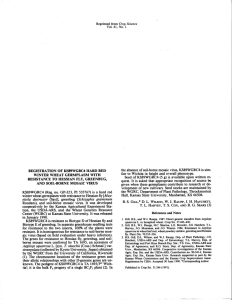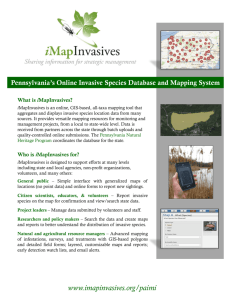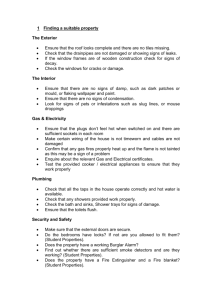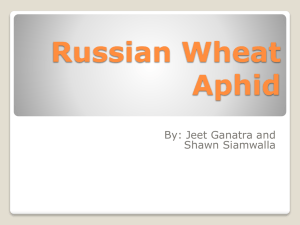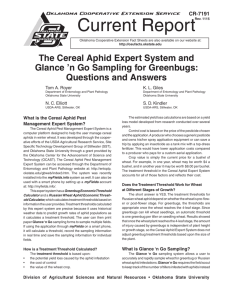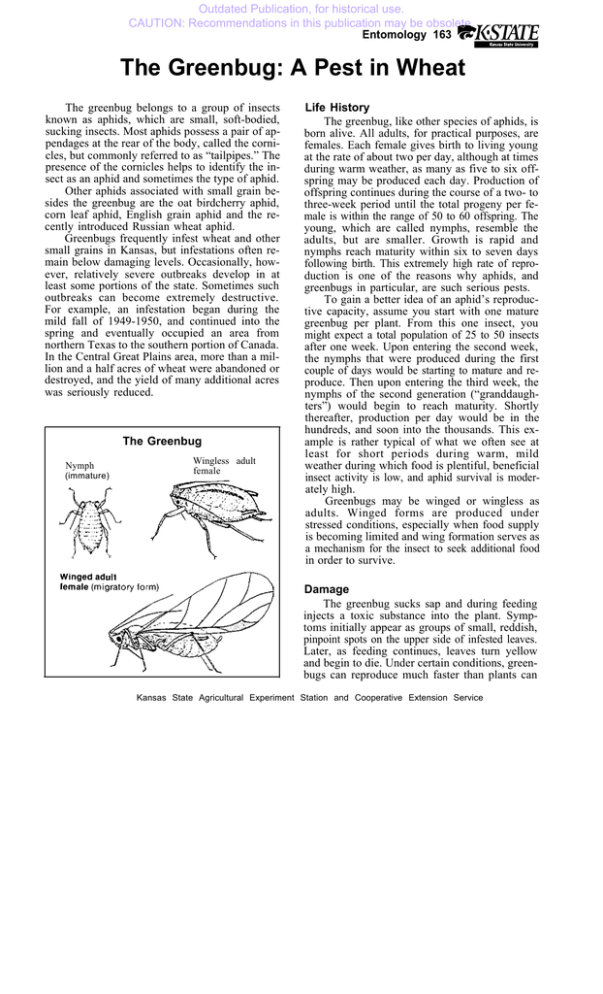
Outdated Publication, for historical use.
CAUTION: Recommendations in this publication may be obsolete.
Entomology 163
The Greenbug: A Pest in Wheat
The greenbug belongs to a group of insects
known as aphids, which are small, soft-bodied,
sucking insects. Most aphids possess a pair of appendages at the rear of the body, called the cornicles, but commonly referred to as “tailpipes.” The
presence of the cornicles helps to identify the insect as an aphid and sometimes the type of aphid.
Other aphids associated with small grain besides the greenbug are the oat birdcherry aphid,
corn leaf aphid, English grain aphid and the recently introduced Russian wheat aphid.
Greenbugs frequently infest wheat and other
small grains in Kansas, but infestations often remain below damaging levels. Occasionally, however, relatively severe outbreaks develop in at
least some portions of the state. Sometimes such
outbreaks can become extremely destructive.
For example, an infestation began during the
mild fall of 1949-1950, and continued into the
spring and eventually occupied an area from
northern Texas to the southern portion of Canada.
In the Central Great Plains area, more than a million and a half acres of wheat were abandoned or
destroyed, and the yield of many additional acres
was seriously reduced.
The Greenbug
Nymph
(immature)
Wingless adult
female
Life History
The greenbug, like other species of aphids, is
born alive. All adults, for practical purposes, are
females. Each female gives birth to living young
at the rate of about two per day, although at times
during warm weather, as many as five to six offspring may be produced each day. Production of
offspring continues during the course of a two- to
three-week period until the total progeny per female is within the range of 50 to 60 offspring. The
young, which are called nymphs, resemble the
adults, but are smaller. Growth is rapid and
nymphs reach maturity within six to seven days
following birth. This extremely high rate of reproduction is one of the reasons why aphids, and
greenbugs in particular, are such serious pests.
To gain a better idea of an aphid’s reproductive capacity, assume you start with one mature
greenbug per plant. From this one insect, you
might expect a total population of 25 to 50 insects
after one week. Upon entering the second week,
the nymphs that were produced during the first
couple of days would be starting to mature and reproduce. Then upon entering the third week, the
nymphs of the second generation (“granddaughters”) would begin to reach maturity. Shortly
thereafter, production per day would be in the
hundreds, and soon into the thousands. This example is rather typical of what we often see at
least for short periods during warm, mild
weather during which food is plentiful, beneficial
insect activity is low, and aphid survival is moderately high.
Greenbugs may be winged or wingless as
adults. Winged forms are produced under
stressed conditions, especially when food supply
is becoming limited and wing formation serves as
a mechanism for the insect to seek additional food
in order to survive.
Damage
The greenbug sucks sap and during feeding
injects a toxic substance into the plant. Symptoms initially appear as groups of small, reddish,
pinpoint spots on the upper side of infested leaves.
Later, as feeding continues, leaves turn yellow
and begin to die. Under certain conditions, greenbugs can reproduce much faster than plants can
Kansas State Agricultural Experiment Station and Cooperative Extension Service
Outdated Publication, for historical use.
CAUTION: Recommendations in this publication may be obsolete.
grow, and if undisturbed, infestations can become
severe enough to kill the entire plant. Greenbugs
tend to congregate on the underside of the lower
leaves and gradually move upward as the population expands. The damage to wheat is believed to
be a function of both levels of infestation and the
length of time when a given infestation is present.
Infestations may occur as spots or as a general infestation throughout the field. Sometimes
there appears to be a pattern in development associated with thin spots (more under cultural control) or in areas near windbreaks or farmsteads.
Recognizing Infestation
Patterns in Wheat
The greenbug can infest small grains at almost any time during the growing season, but
most infestations can be categorized with respect
to the general time they occur. These patterns are
illustrated in the figures that follow:
Early-Fall Infestations
(Type 1 Problem)
Figure 1 shows an example of an early season
infestation. For simplicity it is called a Type 1
problem. In this case, greenbug activity is high in
late August and early September, just about the
time the earliest planted wheat is beginning to
emerge. The source of infestation may be from
sorghum or from movement of winged greenbugs
from an unknown source. Unusually cool, late
summer conditions may favor this occurrence.
Usually these early season infestations are of relatively short duration, and they are often eliminated either by rains or an increase in beneficial
insect activity:
Fig. 1
Early planted acreage most
susceptible.
Mid- to Late-Fall Infestations
(Type 2 Problem)
Another developmental pattern is illustrated
in Figure 2. It encompasses the period between
the first killing frost and onset of winter dormancy in wheat. Beneficial insect activity nor-
mally declines markedly after the first frost, and
if the weather remains mild and dry, it provides
an ideal opportunity for greenbug development. It
is during this period from late October through
November when fall infestations are most likely
to occur in Kansas. The production of winged
greenbugs may accelerate and increase the rate
of dispersal. Within days, greenbugs may begin
to appear across large areas of the state. Severity
of the problem varies with the year. Damage,
if it occurs, is usually confined to the southern
areas, but spots in the north will sometimes suffer injury. Usually infestations start to decline
by late November as colder weather begins to
predominate.
Overwintering Requirements
Generally the greenbug does not survive the
winter in Kansas, except during about one year
out of 10, and even then survival is usually limited
to the southernmost counties. Greenbugs, unlike
some pests, do not have a dormant stage, thus
overwintering survival is determined by weather
factors along with the amount of protection provided in a given field. As a rule, when temperatures drop below 40°F, reproduction becomes
greatly curtailed, and mortality increases as
temperatures continue to decline. Cold, wet
weather is especially detrimental. Even so, infestations may be able to withstand short periods of
0°F temperatures. (The difference in air versus
soil surface temperature can be surprising. )
However, it is hard for the insect to withstand long
periods of cold; thus, some 0°F weather followed
by several days of subfreezing temperatures are
usually needed to eliminate an infestation.
Early-Spring Infestations
(Type 3 Problem)
Outbreaks that develop during the early
spring period (February to April) are usually the
result of a fall infestation that successfully survived the winter. When this happens, infestations
may begin to escalate rapidly at or just after
Outdated Publication, for historical use.
CAUTION: Recommendations in this publication may be obsolete.
green-up time. Damage usually appears first in
the southern areas where overwintering numbers
were higher, but may soon spread to other portions of the state.
At times, growers maybe unaware of a problem until “greenbug spots” (areas of yellowish to
brownish plants) begin to appear. The plants in
these spots are usually near death as a result of
either high numbers of greenbugs, or greenbugs
in addition to other stresses. Often infestations
are high enough throughout such fields to warrant
treatment, though it may be tempting to treat
only the areas showing stress.
Beneficial insect numbers tend to be relatively low at green-up time (though not always),
but soon begin to increase in response to climbing
temperatures and the presence of greenbugs. Historically, by about mid-April, beneficial insects
have reached numbers sufficient to begin bringing these early spring greenbug outbreaks under
control.
Late-Spring Infestations
(Type 4 Problem)
It is not unusual to encounter beginning infestations late in the season as wheat approaches the
heading stage. Occurrence is more likely during
periods of dry, mild weather—especially during
years in which early infestations fail to occur. Although these late season infestations usually are
not of economic concern on wheat, they do appear
to serve as the major source of infestation for
seedling sorghums.
Management Considerations
Cultural Control
Few cultural practices are known to be reliable in greenbug control on wheat or small
grains. However, one aspect of greenbug behavior
may be worthy of mention. Observers in watching
greenbug flights have noticed that when a choice
is available, migrating winged greenbugs appear
to prefer settling in fields with large amounts of
bare, exposed soil. In other words, large numbers
tend to settle in a field with a thin stand compared
to a nearby one with a denser stand; or a newly
emerging field over an adjacently established
field; or in some cases in a field with a minimum
of surface residue compared to one with a large
amount of straw on the surface. Perhaps with additional studies, some practical cultural management guidelines can be developed to take advantage of behavioral observations.
Weather
The importance of weather in overwintering
is described on page 2. Mild, dry weather favors
greenbug development. As temperatures increase, greenbugs reproduce faster, up to a point.
When temperatures climb above the mid-90s, the
amount of survival and rate of reproduction become affected, and one may observe that greenbugs have greater difficulty surviving on the
more exposed upper parts of plants. Survival also
becomes more difficult during hot weather under
moisture-stressed conditions. Hot, drying winds
usually result in a decline in numbers, especially
in dryland fields and where greenbugs are relatively exposed. Beating rains may dislodge or
drown the insects and frequently eliminate an infestation, especially where the plants are too
small to provide much shelter.
Beneficial Insects
A variety of beneficial insects attack the
greenbug. Lady beetles and parasitic wasps are
the ones of major importance. Often lady beetles
are of greater importance in the beginning of
spring infestations, with parasites coming on
later in sufficient force to bring outbreaks under
control. The abundance of beneficial insects
should always be considered in evaluating greenbug infestations. For instance, if lady beetles average one (larva or adult) per three or four feet of
drill row, this may be sufficient to destroy a light
to moderate infestation of greenbugs (infestations in the range of 50 to 75 per foot of row or less ).
Outdated Publication, for historical use.
CAUTION: Recommendations in this publication may be obsolete.
When lady beetle numbers similar to this are
encountered, it may be advisable to postpone
treatment decisions and resample as necessary
during the next several days.
When parasitism reaches a level of between
10 and 15 percent (unless greenbug numbers are
extremely high), it is advisable to delay treatment decisions, but continue to resample at twoto three-day intervals until the trend in population
development is established.
Making Treatment Decisions
Current management recommendations suggest the use of insecticides when moderate numbers of the greenbug are present; the population
appears to be increasing; some plants are showing signs of stress; beneficial insects are relatively low and weather conditions are expected to
remain favorable for greenbug development for
the next several days. The guide on this page is
useful in estimating control needs based on various plant growth stages.
For a list of recommended insecticides, consult the current year’s edition of Wheat Insect
Management Recommendations, MF-745, available in County Extension Offices.
Number of
greenbugs
Stage of per linear
plants
foot
Comments
A relatively small
Seedlings, thin 50
stands, less
number of greenbugs
than 3 tillers
may cause injury,
particularly prior to
tillening and secondary root formation.
100-300 Somewhat higher
3-to 6-inch
numbers may be tolwheat, 3 tillers
or more
erated after tillening
begins and secondary
roots are established.
Plant vigor and stand
density should also be
considered.
vigorous
6-to 12-inch
300-500 Dense,
stands can withstand
wheat, Later
growth stages
some moderately high
infestations for a brief
time, but damaging
levels may be initially
overlooked if not routinely sampled.
Greenbugs are rarely
of economic concern
after jointing.
Brand names appearing in this publication are for product identification purposes only. No endorsement is intended,
nor is criticism implied of similar products not mentioned.
Publications from Kansas State University are available on the World Wide Web at: http://www.oznet.ksu.edu
Contents of this publication may be freely reproduced for educational purposes. All other rights reserved. In each case, credit H. Leroy Brooks,
The Greenbug: A Pest in Wheat, Kansas State University, June 1989
Kansas State University Agricultural Experiment Station and Cooperative Extension Service
MF-925
June 1991
It is the policy of Kansas State University Agricultural Experiment Station and Cooperative Extension Service that all persons shall have equal opportunity and access to its educational programs, services, activities, and materials without regard to race, color, religion, national origin, sex, age or disability.
Kansas State University is an equal opportunity organization. Issued in furtherance of Cooperative Extension Work, Acts of May 8 and June 30, 1914, as
amended. Kansas State University, County Extension Councils, Extension Districts, and United States Department of Agriculture Cooperating, Marc A
Johnson, Director.
File Code: Entomology 2

